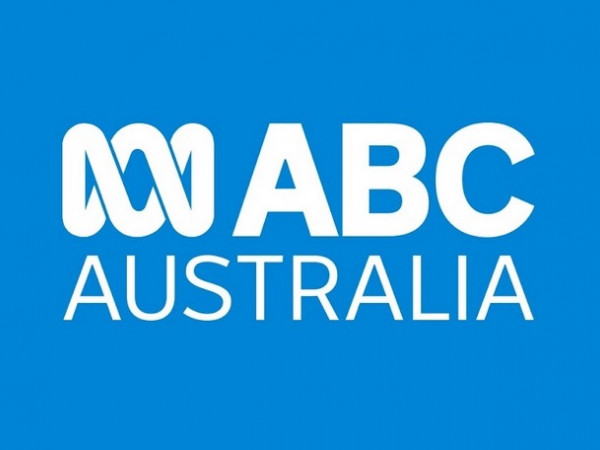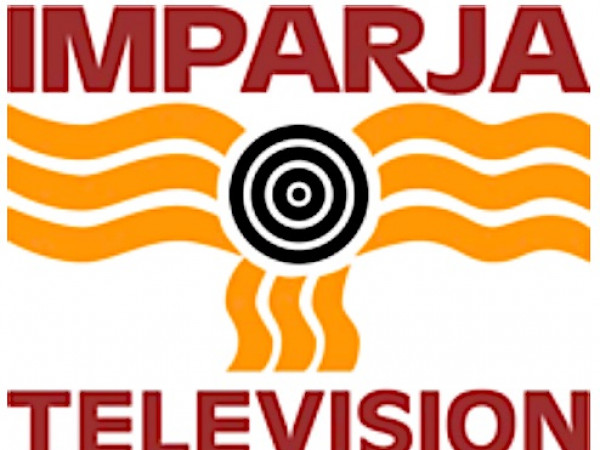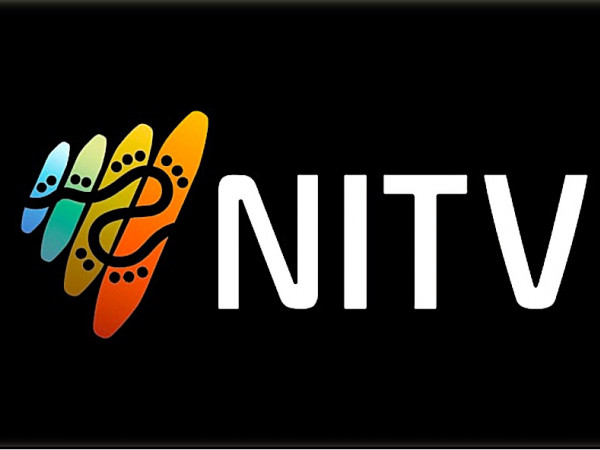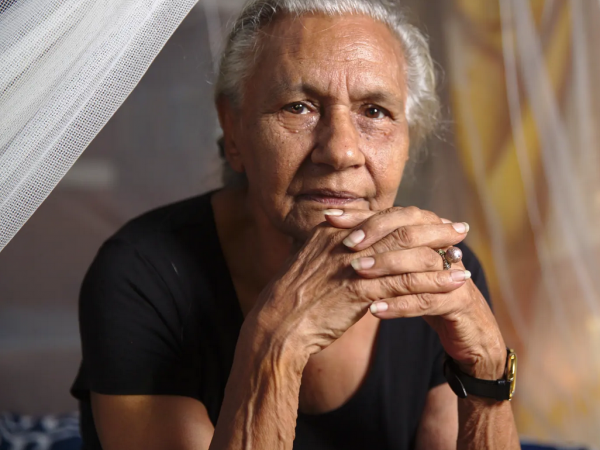Rhoda Roberts
“So now we have to bring back the fires…”
So, I was broadcasting in community radio, and then also I had an ABC Radio show. And at the time I was also working as an actor - an audition came up for a new television series at SBS, and so I went for the auditions, and luckily enough I got that show, which was fantastic because it wasn't just about presenting or hosting a show it's also developing and producing stories, and then I moved on to doing documentaries.
And not only with First In Line but Vox Populi was a great opportunity to showcase stories that were literally good news stories, but also gave another perception, a different lens if you would like. And I think it was when we started see stories where people were authoring their own careers, showed the difference.
…there were many people who, an Aboriginal story meant that it was a problematic story, an Aboriginal story meant that it would be Aboriginals standing up for their rights and waving the flag. And so, I would imagine, I know when we were doing theatre if you put up a particular image that really resonated as an Aboriginal image people steered away from it. So, I think there was that progress where we went: ‘Let's embrace them bring them in give them a human issue story that they too can relate to’, and then switch it slowly by having our lens, but also soft stories will bring us a dedicated audience, and then we can slowly grow with them. And I think that did occur, and you know we went from the soft stories to also ensuring that there were political stories, and very much information-based stories that showed a different viewpoint and a real viewpoint.
But we also were very aware that not consistently have those ‘worthy’ stories: so, all of a sudden, an Aboriginal piece or a First Nations piece became the ‘worthy’ and everyone felt they had to be very serious and they couldn't…. And I think that's where now we've moved on to having the fun. So, if you look at our ABC broadcaster or SBS and NITV, we've got shows, comedy shows that really tackle those serious problems, but in the humour that we deal with in our everyday communities. I mean from the Irish to us, when you're dealing with occupation, you have to be funny because otherwise you will just go under. So, and that's the shift we've seen, and the control within small screen is the dramas and the stories that have a bit of tragedy involved, but of course there is that laughter at the end of the day, and we can laugh with ourselves, and we hope Australians will laugh with us not at us. And I think that's been the switch. And then if you look at the big screen, from the films that are hitting Cannes, from Sapphires to Warwick Thornton’s Sweet Country, you can see that progressively the film industry in particular had an extraordinary model about 40 years ago, and that has really shown its success.
Sadly, all these years later we still face an enormous difficulty or challenge within the industry, that we are seeing some really incredible positive dramas, documentaries, we even have our own national television service now. So, we've moved ahead quite significantly. However, if you were to look at the average Australian viewing time on television, they're looking at the mainstream channels and very sadly still, within those mainstream outlets we're not seeing the progression of stories that we're telling in our own lens. And also, we're still facing many of the issues with the various negative statistics. So, we'll constantly hear on the mainstream media, the high incarceration rates, the youth unemployment. Now of course it's about the sexually transmitted diseases in young children and the chaos in communities. What we're not seeing is the very slow changes that have occurred and time takes… and change takes time. And there's been amazing things done in communities and we're starting to see, you know I think it takes about 30 years to see the effect of that perception of who we are.
So those stories aren't … I guess Australians aren't hearing those stories, so they still have that perception that one or …the damaging stereo… negative statistics: they're not seeing the empowerment of young leadership that is really challenging and changing not only our own communities but industry. You know, we have people now who've gone through university - we have almost a new middle class if you would like, and they are really, they are in the system. But they're ensuring that that system understands their authoring, and I think it's…slowly seeping through now. But you know, from… aviation to the health industry, to finance and future marketers, we have Aboriginal people represented - virtually in every industry and some at a very high level. But the most significant change I think, we’ve seen since the last time we spoke is that there is a group of young people who have become very entrepreneurial and so the independent companies, businesses have escalated. Now you wouldn't know it if you were just watching television in Australia.
Look, I think there's a couple of elements there. One was the fact that CAAMA had grown out of central Australia. There were quite a number of shows that are now on the East Coast - such as Radio National's Awaye! Program - that also came out of the Central Area. Look, in Australia there's still sadly that attitude, and I think the profiling of Aboriginal stories through the mainstream media has articulated this, and sadly, is that there is that focus that you're not a real Aboriginal unless you come from the Central. Areas - which is just a load of bollocks, but they did, I guess, romanticize, because in those communities they were still living on remote communities, they're still heavily dependent on government finance - the missionary mentality - that was the reality of the day. But I think working in the industry, we worked with those wonderful organisations. I mean, what CAAMA did for the broadcasting arena - as what Radio Redfern did prior to CAAMA - affected the national scope and picture of what was happening. We were able to set up our National Indigenous Radio Service. which of course is made out of Brisbane. So, things have shifted, but again there is still that issue with the mainstream media where they do romanticize, or sadly, very problematic - the stories coming out of the western central desert regions, and that continuous profiling of - you might have two incredible contemporary artists, but the artists coming from the Northern Territory more than likely get more of the exposure than the artists coming from the East Coast. So NITV, SBS, ABC have set themselves a challenge to ensure that the coverage and the vision of stories is embedded across all communities - not just those. And it's a bit of work to do. You know, forever people have romanticized the nomadic savage, the noble savage, but in fact we know that was never true - we were never nomadic. In fact, we were cultivators and farmers and harvesters. We would not have survived the Ice Age had we not been. If we did not process our food we …wouldn't be alive. So, history is starting to slowly change and shift from those old anthropological documents to, well, yes they did… you know, in one document an anthropologist says ‘They were cultivating the grasses for seeds. We don't know if they did this deliberately or if it was just chance’. Well, of course they were processing and harvesting for the next season. So, elements of conversation like that have shifted now - that dialogue is very 1950s, and of course it's not appropriate to say those sorts of things today. So, we're starting to see that shift. But I as an East Coast - I'm a Wiyebal woman from northern New South Wales, Bundjalung territories - media has always played a big part in our lives. Prior to CAAMA being set up we had incredible pioneers like Justine Saunders, Brian Syron and Bob Maza - just to mention just very few who were making shows on the East Coast for national exposure. They were also involved as actors and producers and directors in mainstream television. So, they were doing work in the 70s that possibly went unnoticed because we didn't have the outlets to tell the story. And so, by the time CAAMA comes along there is an outlet. And so, they focused on the stories that were real to them. Out of CAAMA of course, with the incredible amazing pioneer Freda Glynn - to then produce Imparja television was… when you look back, in hindsight and you can imagine the incredible challenges. That was a significant move which I don't think historically has ever really been celebrated in a way that it should. It was the coming of television for many communities. It was that big. It changed their lives.
But television did change our lives. I know as a young person we would have various rituals that were performed at seasonal times. People would gather on the beach - and I remember as a child, or a young teenager walking on the beach, and you go from one fire to the next, to the next, the next - to different family groups having a chat, a yarn, and having fun. And as television came in and people were able to afford it, slowly the fires died and everyone was in their lounge room watching the TV. And that's a huge shift from a cultural base. So now we have to bring back the fires, but in a new way. And you know, from digital technology now we're seeing where we're able to tell the story perhaps stronger but with more depth - and with more opportunities for cultural knowledge. So, you know, virtual reality, we've told a few, made a few stories recently. And so that's enabling the viewer not only to be in country almost, sitting on country because of the VR content but also the dialogue is about depth. And that's really important. We've done the soft stories we've told…we're here and now, we need to add other layers to it. And I think that is an obligation and a responsibility of every network. You can't just be there making pretty stories. We have an obligation because we come from that kinship system.
It’s interesting with social media we're seeing a huge shift of how we communicate the old Bush Telegraph. You know, we're great communicators so you can put a story on Facebook or a request for something in two minutes you've got 300 people responding. It's quite significant - Facebook is used, and I believe one of the Facebook statistics which is a good statistic is First Nations people of Australia per capita are the highest users of Facebook. It's free, we can use it anywhere. It's accessible. It's quite interesting if you go onto Facebook and look at all the various different sites - it's phenomenal actually. But again, it can be a hindrance. We've seen with Sorry Business, or cultural matters where it's been abused on Facebook, and issues are occurring when people are reading about material they shouldn't be reading until it's done in a more cultural way. And so, there is a fine line between, what can be damaging and what can be helpful.




